PHILIPPINES
(Updated in 2012)
1. GENERAL INFORMATION
1.1 Country Overview
The Philippines is readily accessible from the travel capitals of the world.
An archipelago of 7,107 islands, the Philippines stretches from the south of China to the northern tip of Borneo. The country has over a hundred ethnic groups and a mixture of foreign influences, which have molded a unique Filipino culture.
Considered the third-largest English speaking country in the world, the Philippines has world-class facilities and services such as excellent accommodation, fine restaurants, modern shopping centers and communication services, efficient conference and exhibition organizers and reliable tour operators.
The country is divided into three geographical areas, Luzon, Visayas and Mindanao. It has 16 regions and 79 provinces. The capital city is Manila. The total land area is 115,600 square miles/299,404 square km.
1.1.1 Government System
The Republic of the Philippines is a constitutional democracy, with the President as head of state. The president and vice president are elected by the people for six-year terms. The national government has three equal branches that exercise a system of checks and balances: executive, legislative and judicial.
The executive branch consists of the 26 members of the cabinet secretariat and equivalent ranks in specialized agencies, the national bureaucracy and the military, of which the president is Commander-In-Chief. The legislative branch of congress is a two-chamber legislature. There are 24 senators in the Philippine Senate, while there are 22 Congressmen or House Representatives. The judicial branch consists of the Supreme Court, the Court of Appeals, Regional Trial Courts and other special courts (i.e. Juvenile, Family or Sharing Courts).
Sources: eTravel Pilipinas
Department of Tourism Promotions Board
1.1.2 GEOGRAPHY AND CLIMATE
The Philippine archipelago lies in Southeast Asia in a position that has led to its becoming a cultural crossroads. It is a place where Malays, Chinese, Spaniards, Americans and others have interacted to forge a unique cultural and racial blend known to the world as Filipino. The archipelago numbers some 7,107 islands, as the nation claims an exclusive economic zone (EEZ) of 200 nautical miles from its shores. The Philippines occupies an area that stretches for 1,850 kilometers from about the fifth to the twentieth parallels north latitude. The total land area is almost 300,000 square kilometers. Only approximately 1,000 of its islands are populated, and less than one half of these are larger than 2.5 square kilometers.
Islands make up of 94% of the Philippine land mass, and two of these – Luzon and Mindanao – measure 105,000 and 95,000 square kilometers, respectively. They, together with the cluster of the Visayas islands that separate them, represent the three principal regions of the archipelago, which are identified by the three stars on the Philippine flag.
Topographically, the Philippines is broken up by the sea, which gives it one of the longest coastlines of any nation in the world. Most Filipinos live on or near the coast, where they easily supplement their diet from approximately 2,000 species of fish.
Off the coast of eastern Mindanao is the Philippine trough, which descends to a depth of 10,430 meters. The Philippines is a part of a Western Pacific arc system that is characterized by active volcanoes. Among the most notable peaks are Mount Mayon near Legazpi, Taal Volcano, South of Manila, and Mount Apo in Mindanao. All of the Philippine islands are prone to earthquakes. The Northern Luzon highlands, or Cordillera Central, rise to between 2,500 and 2,750 meters, and, together with the Sierra Madre in the northern portion of Luzon and the mountains of Mindanao, boast rainforests that provide refuge for numerous upland tribal groups. The rainforests also offer prime habitat for more than 500 species of birds, including the Philippine eagle (or monkey-eating eagle), and some 800 species of flowering plants.
The country’s most extensive river systems are the Pulangi (Rio Grande), which flows into the Mindanao River, the Agusan, in Mindanao, which flows north into the Mindanao Sea, and the Cagayan, in Northern Luzon, which flows into Manila Bay. Laguna de Bay, southeast of Manila Bay, is the largest fresh water lake in the Philippines. Several Philippine rivers have been harnessed for hydroelectric power.
The Philippines, officially known as the Republic of the Philippines, is a country in Southeast Asia with Manila as its capital city.
The Philippines is the world’s 12th most populous country, with a population of about 94 million people. Its national economy is the 45th largest in the world, with an estimated 2010 gross domestic product (GDP) Purchasing Power Parity of US$ 351.4 billion. There are more than 11 million overseas Filipinos worldwide, estimated to be about 11% of the population.
A former colony of Spain and the United Sates, the Philippines is one of the two predominant Roman Catholic countries in Asia, the other being east Timor. There are also a number of minority religious groups, including Islam, Buddhism and Hinduism. Multiple ethnicities and cultures are found throughout the islands. Ecologically, the Philippines is one of the diverse countries in the world.

The climate of the Philippines is a tropical marine climate, dominated by a rainy season, a dry season and a cool season that dominates from November to mid- February. The summer monsoon brings heavy rains to most of the archipelago from May to October, whereas the winter monsoon brings cooler and drier air from December to February. Manila and most of the lowland areas are hot and dusty from March to May. Even at this time, however, temperatures rarely rise above 37°C (99°F). Mean annual sea level temperature rarely falls below 27°C (81°F). Annual average rainfall ranges from as much as 5,000 mm (200 in), in the mountainous east coast section of the country, to less than 1,000 mm (39 in) in some of the sheltered valleys. Monsoon rains, although hard and drenching, are not normally associated with high winds and waves. Nonetheless, the Philippines sits astride the typhoon belt, and the country suffers an annual onslaught of dangerous storms from July through to October. These are especially hazardous for Northern and Eastern Luzon and the Bicol and Eastern Visayas regions, but Manila gets devastated periodically as well.
1.1.3 POPULATION
More than 55% of the Philippine population lives on the northern island of Luzon. The National Capital Region (NCR) and parts of Luzon are the most densely populated areas of the country. More than 9.9 million (13.0%) people live here. The total area of the National Capital area is 636 km2 (0.2% of the country’s total land area), and its density is 15.617 people per km2.
TABLE 1. POPULATION INFORMATION
| 1980 | 48.32 | |
| 1981 | 49.54 | 2.52 |
| 1982 | 50.78 | 2.50 |
| 1983 | 52.06 | 2.52 |
| 1984 | 53.35 | 2.48 |
| 1985 | 54.67 | 2.47 |
| 1986 | 56 | 2.43 |
| 1987 | 57.4 | 2.50 |
| 1988 | 58.7 | 2.26 |
| 1989 | 60.1 | 2.39 |
| 1990 | 61.5 | 2.33 |
| 1991 | 63 | 2.44 |
| 1992 | 64.4 | 2.22 |
| 1993 | 65.9 | 2.33 |
| 1994 | 67.514 | 2.45 |
| 1995 | 68.35 | 1.24 |
| 1996 | 69.952 | 2.34 |
| 1997 | 71.55 | 2.28 |
| 1998 | 73.148 | 2.23 |
| 1999 | 74.746 | 2.18 |
| 2000 | 76.947 | 2.94 |
| 2001 | 78.568 | 2.11 |
| 2002 | 80.217 | 2.10 |
| 2003 | 81.878 | 2.07 |
| 2004 | 83.559 | 2.05 |
| 2005 | 85.261 | 2.04 |
| 2006 | 86.973 | 2.01 |
| 2007 | 88.706 | 1.99 |
| 2008 | 90.457 | 1.97 |
| 2009 | 92.227 | 1.96 |
| 2010 | 94.013 | 1.94 |
| July, 2011 | 101.834 |
Source: CIA World Fact book
The Ultrecht Faculty of Education
1.1.4 ECONOMIC DATA
GDP – per capita (PPP): $ 3,500.00 (2010 est.)
$ 3,300.00 (2009 est.)
$ 3,400.00 (2008 est.)
Note: Data are in 2010 US Dollars
GROSS DOMESTIC PRODUCT
| 1980 | 1333.653 | |
| 1981 | 1417.416 | 10.33% |
| 1982 | 1578.176 | 7.26% |
| 1983 | 1630.246 | 3.30% |
| 1984 | 1529.699 | 6,17% |
| 1985 | 1425.582 | 6.81% |
| 1986 | 1471.09 | 3.19% |
| 1987 | 1540.544 | 4.72% |
| 1988 | 1663.392 | 7.97 |
| 1989 | 1790.616 | 7.65 |
| 1990 | 1872.576 | 4.58 |
| 1991 | 1881.827 | 0.49 |
| 1992 | 1890.932 | 0.48% |
| 1993 | 1928.694 | 2.0% |
| 1994 | 2006.605 | 4.04% |
| 1995 | 2118.026 | 5.55% |
| 1996 | 2232.211 | 5.39% |
| 1997 | 2336.043 | 4.65% |
| 1998 | 2297.494 | 1.65% |
| 1999 | 2351.773 | 2.36 |
| 2000 | 2436.914 | 3.62% |
| 2001 | 2511.177 | 3.05% |
| 2002 | 2590.501 | 3.16% |
| 2003 | 2720.136 | 5.00% |
| 2004 | 2904.954 | 6.79% |
| 2005 | 3060.982 | 5.37% |
| 2006 | 3260.12 | 6.51% |
| 2007 | 3506.775 | 7.57% |
| 2008 | 3661.144 | 4.40% |
| 2009 | 3670.467 | 0.25% |
| 2010 | 3920.148 | 6.80% |
GDP – Real Growth Rate: 7.3% (2010 est.)
1.1% (2009 est.)
3.7% (2008 est.)
GDP (Purchasing Power Parity): $ 351.4 billion (2010 est.)
$ 327.4 billion (2009 est.)
$ 323.9 billion (2008 est.)
Note: Data are in 2010 US Dollars
Source: CIA World Fact Book
1.2 ENERGY INFORMATION
1.2.1 Estimated Available Energy
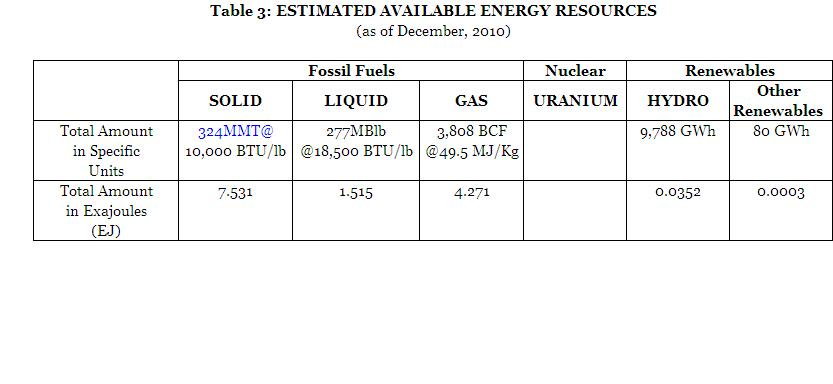
1.2.2 Energy statistics
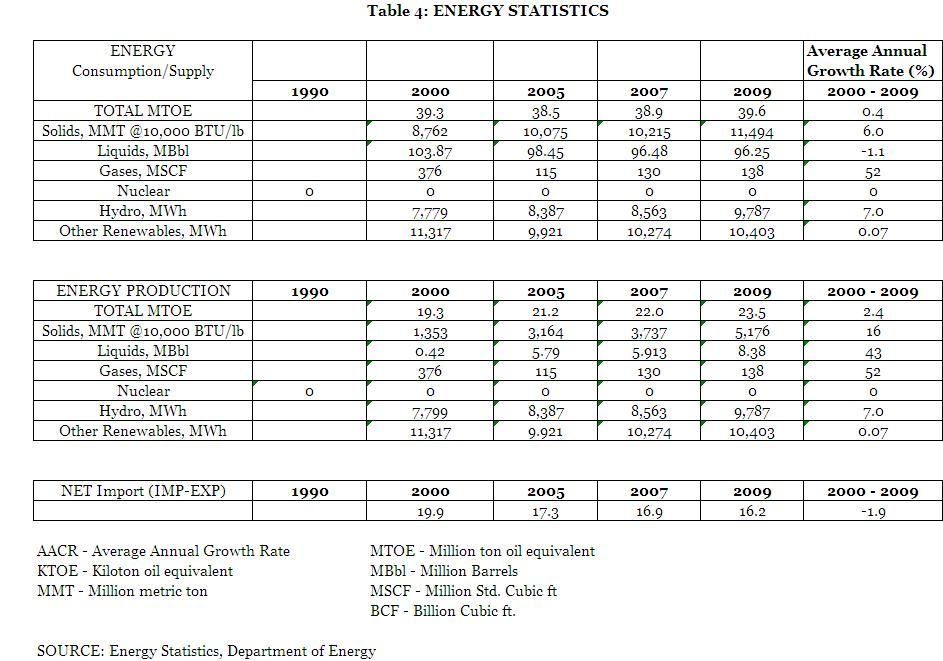
1.2.3 Energy Statistics
As the country faces the realities of growing energy demand, tight energy supply, limited foreign investment and critical power development issues, the Department of Energy is set to release the Philippine Energy Plan. This will highlight the plans and programs of the energy sector to fuel support for the economic growth of the country for the period 2009-2030.
The plans and programs of PEP 2009-2030 will see to it that public policies of energy are on a par with the changing needs of the energy sector.
As an overall guiding principle, the plan is based on three broad policy thrusts:
Ensuring energy security
Pursuing effective implementation of energy sector reforms
Implementing social mobilization and cross-sector monitoring mechanisms
ENERGY PLANS AND PROGRAMS
Since the path to energy security cannot rely on one option only, the PEP has laid out essential steps to support the policy thrusts of the energy sector. Below are the plans for the 20-year planning horizon.
Exploration/Development of Conventional Fuels
The country’s conventional energy fuels – oil, gas and coal – will remain indispensable in meeting the country’s energy demand even as the country pursues other alternative energy sources.
OIL AND GAS
For fossil fuel like oil and gas, the target production level at the end of the planning horizon is 78.59 million barrels. Service contracts, which to date total to about 34, will increase to 117 by 2030. Assuming the realization of these targets, hydrocarbon resources will increase by 40% during the planning period. The country has 16 sedimentary basins and the majority of these areas are found in Luzon, particularly in Palawan.
COAL
Indigenous coal production will increase to 250%, with the entry of more investors through the energy contracting mechanisms and the conversion of existing coal operating contracts from exploration to development stage.
Currently, the Philippines imports around 75.4% of the domestic coal requirements.
GOING FOR CLEAN AND GREEN ENERGY
RENEWABLE ENERGY
Renewable energy development was given a tremendous boost with the passage of the Renewable Energy Act of 2008. Since its passage, a total of 206 contracts have been signed. The target is to double the RE-based installed capacity for power generation by the end of the planning horizon, from its 2008 level of 5,300 MW.
In the case of geothermal, a comparatively more advanced resource, the targeted installed capacity will increase from 1,972 to over 3,000 MW by the end of the planning horizon, boosting the country’s leadership in geothermal energy development worldwide.
NUCLEAR
There is a global revival of interest in nuclear energy as an alternative energy source. Along these lines, the secretaries of the Department of Energy and the Department of Science and Technology jointly created an inter-agency task force to exactly determine the feasibility of nuclear energy as a long term option in the Philippines. The task force validated the results of the BNPP feasibility study in 2009, which is the main output of a Memorandum of Understanding (MOU) between the National Power Corporation and KEPCO. It also undertook a site safety review of the BNPP. A study on the competitiveness of nuclear power compared to other fuel sources will also be conducted, and personnel trained
Promoting Responsible Use of Energy
The government is developing opportunities to make realistic changes to the way the country uses its energy resources. Energy conservation programs and technologies will help Filipinos become efficient consumers of energy. For the energy efficiency program, the plan aims to achieve 10% energy savings on total annual demand from all economic sectors.
Other programs to be implemented are the monitoring of efficiency performance of power generation utilities and electric distribution facilities, promotion of aviation fuel efficiency enhancement, retrofit of commercial and industrial establishments, and a voluntary agreement program on the rationalization of tricycle operation.
Ensuring Developments in the Power and Electrification Sectors
Given the critical periods in the major grids, between 2009-2030, the plan provides a list of projects that will come on line at various times. This will include committed projects that essentially have financial backing already, and considered projects that are in various stages of development. A 600 MW coal-fired plant is a committed project for the Luzon, to be made available in 2012, while in the Visayas, two (2) committed coal power plants will bring in 328 MW of additional capacity. Additionally, 4 further power projects were introduced in 2011, with an additional capacity of 325 MW. For Mindanao region, the Sibulan Hydropower plant (42.5 MW) is expected to come on line, as well as the Cabulig Hydropower Project (8 MW) this year, and the Mindanao Geothermal Project (50 MW) by 2014.
USING ENERGY IN AN ENVIRONMENTALLY RESPONSIBLE MANNER (CLIMATE CHANGE ADAPTION MEASURES)
The Philippines, like the rest of the world, is facing a moment of decision in terms of using energy in a more environment friendly way. Fully aware of the role and responsibilities of the energy sector in helping to mitigate the impact of climate change, the plan introduces the pursuit of adaptation strategies, among which are as follows: the conduct of impact and vulnerability assessment of energy systems (such as power generation, transmission and distribution, fuel production and transport in the immediate term), integration of structural adaptations into the design of energy infrastructures to include modification of engineering design practices, and integration of climate change adaptation to energy policies, plans and programs including laws and regulations.
Source: Department of Energy Portal (www.doe.gov.ph)
1.3 THE ELECTRICITY SYSTEM
1.3.1 Electricity Policy and Decision Making Process
The Philippine Distribution Code establishes the basic rules, procedures, requirements and standards that govern the operation, maintenance and development of the electric distribution systems in the Philippine Grid Code and the market rules of the Wholesale Electricity Spot Market. Its purpose is to ensure the safe, reliable and efficient operation of the whole electric energy supply system in the Philippines.
Republic Act No. 9136, also known as the “Electric Power Industry Reform Act of 2001”, mandated the creation of the Energy Regulatory Commission (ERC). Section 43(b) of the Act provides that the ERC promulgates and enforce a National Grid Code and a distribution code which shall include, but not be limited to: (a) Performance Standards for TRANSCO O & M Concessionaire, Distributors and Suppliers, and (b) Financial Capability Standards for the Generating Companies, the TRANSCO, distributors and suppliers. The act also mandates the ERC to enforce compliance with the Grid Code, the Distribution Code, and the Market rules, and to impose fines and penalties for any violation of their provisions.
The restructuring of the electric power industry will result in significant changes in operation and management of the distribution system. The Act allows end-users belonging to the contestable market to obtain power from suppliers who are licensed by the ERC. Distributors must provide wheeling services to these end-users. Distributors must also procure energy from the Wholesale Electricity Spot Market and serve the remainder of the customers in their franchise area through bilateral contracts.
The distribution code defines the technical aspects of the working relationship between the distributors and all users of the distribution system. Distributors must deliver electric energy to users at acceptable levels of power quality and customer service performance.
Source: Energy Regulatory Commission (Philippines)
1.3.2 Structure of Electric Power Sector
The Philippine power industry is divided into three major sectors: generation, transmission, and distribution. Under the present power industry structure, NPC generates its own electricity and buys electricity from IPPs. Power generation used to be a monopoly of the National Power Corporation (NPC), until the issuance of Executive Order No. 215, which opened up the generation sector to private investors.
At present, a number of Independent Power Producers (IPPs) generate and sell electricity to NPC and other customers. NPC transmits electricity to distributors and large industrial customers via high voltage wires. NPC is also responsible for constructing the transmission-grid highway, interconnecting the main islands nationwide.
Distribution of electricity at its usable voltage to end-consumers is performed by investor-owned utilities and numerous electric cooperatives, which sell to households as well as to commercial and industrial enterprises located within their franchise areas. Sales are made at retail rates and regulated by the Energy Regulatory Board (ERB). The Department of Energy (DOE) sets policy directions for the energy industry while the National Electrification Administration (NEA) provides financial and technical assistance to electric cooperatives.
The major reforms are embodied in RA 9136. They primarily involve the restructuring of the electricity supply industry, calling for the separation of the different components of the power sector, namely generation, transmission, distribution and supply.
At the same time, the privatization of the National Power Corporation (NPC) involves the sale of the state-owned power firm’s generation and transmission assets (e.g. power plants and transmission facilities) to private investors. These reforms are aimed at encouraging greater competition and at attracting more private sector investors to the power industry. A more competitive power industry will in turn result in lower power rates and a more efficient delivery of electricity supply to end-users.
Source: www.psalm.gov.ph
1.3.3 Main Indicators
Electricity demand is the basic component of development planning as it integrates different electric power subsectors: distribution, transmission and generation. It also indicates the minimum required capacity and production in terms of watt (w) and watt-hour (wh), respectively.
The energy and demand forecast for the Luzon grid is more comprehensive compared to the Visayas and Mindanao grids. It comprises about 74% of nationwide demand being the center of industry and commerce.
Table 5. ELECTRICITY PRODUCTION, CONSUMPTION AND CAPACITY
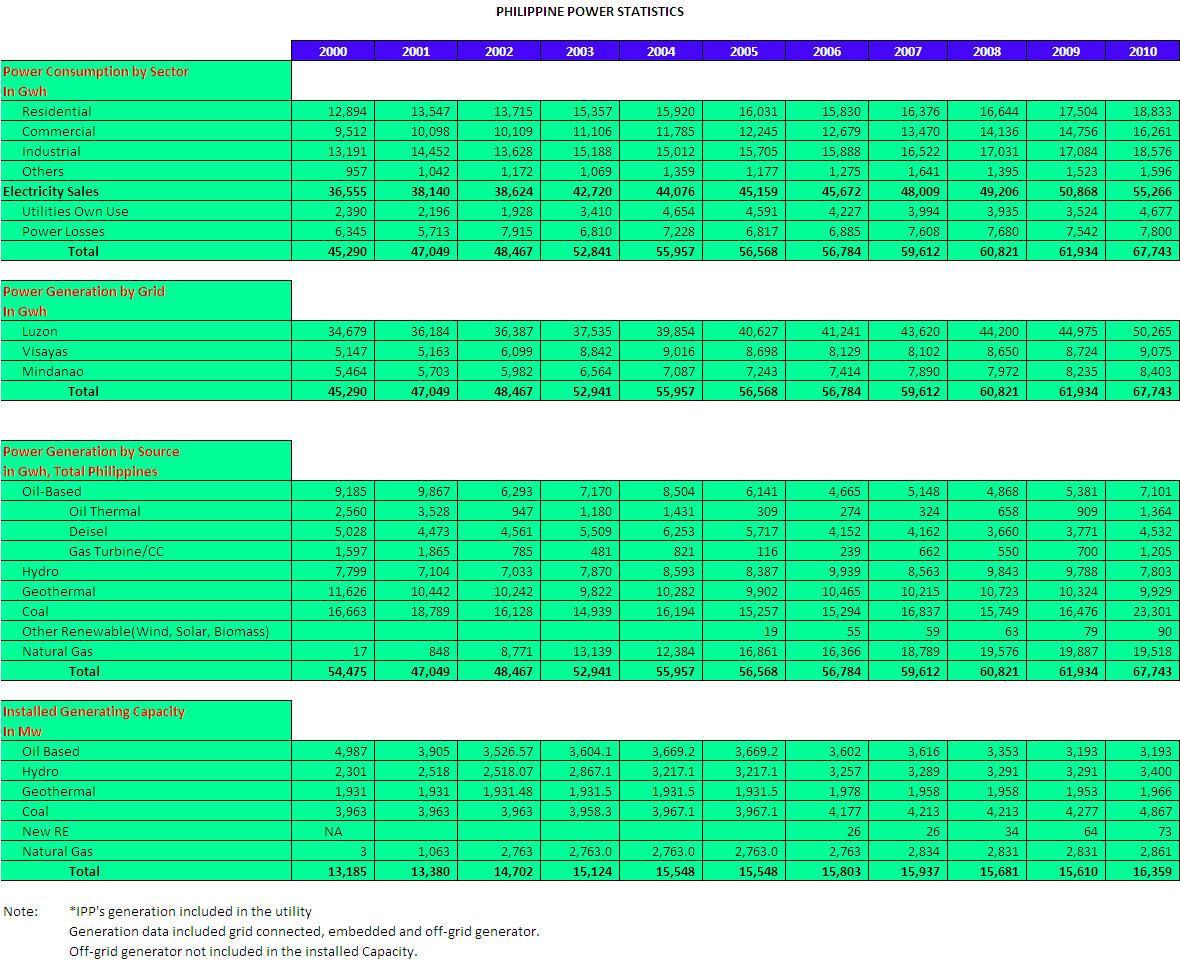
2. 2. NUCLEAR POWER SITUATION
2.1 Historical development and current organizational structure.
2.1.1 Overview
In 1958, the Philippine Atomic Energy Commission (PAEC) was established in accordance with Republic Act 2067, which was supported by then president Carlos P. Garcia.
In 1973, the Philippine economy was under a lot of pressure due to the oil crisis. With the intention of finding an alternative energy source, President Marcos decided, in July of that year, to construct a nuclear power plant. Construction work for the plant started in 1976. In 1979, construction work was put on hold due to the Three Mile Island accident in the United States. A survey of the unfinished power plant showed that it had more than 4,000 defects. It was also pointed out that one of the biggest safety issues behind the BNPP’s construction was that its location was prone to earthquakes. Despite these setbacks, the BNPP was completed in 1984. Its construction cost the government $2.3 billion. With its Westinghouse pressurized water reactor, the BNPP was designed to generate 621 MW of electric energy.
In 1986, the Marcos regime ended and Aquino was installed as president. In April of that same year, the Chernobyl disaster took place. This was a major reason Aquino did not choose to push through with the operation of the BNPP.
The Philippine government tried to legally charge Westinghouse Electric Company for fraudulent schemes in the installment of the Westinghouse nuclear reactor. However, the Unites States court rejected the case.
Succeeding administrations have strained to pay off the debt incurred by the BNPP’s construction. They also tried to come up with ways to convert the nuclear power plant into a fossil fuel-based energy source, although such plans were ultimately deemed economically infeasible. In 2008, a team of surveyors led by Akira Omoto was commissioned to survey the BNPP for possible rehabilitation.
To date, Representative Kimi S. Cojuangco filed House Bill No. 1291; “an act mandating an immediate validation process which satisfies internationally accepted nuclear power industry norms to determine the Bataan Nuclear Power Plant’s operability culminating in either the immediate rehabilitation, certification and commercial operation or the immediate permanent closure and salvage value recovery of the Bataan Nuclear Power Plant, appropriating funds therefore and for other purposes” at the fifteenth (15th) Congress and is awaiting for its approval.
Source: WikiPilipinas Encyclopedia
2.1.2 CURRENT ORGANIZATIONAL CHART(S)
The Philippine Nuclear Research Institute (PNRI) is mandated to undertake research and development activities on the peaceful uses of nuclear energy, to institute regulations on said uses, and to carry out the enforcement of said regulations, to protect the health and safety of radiation workers and the general public.
The Department of Energy (DOE) is the executive department of the Philippine government responsible for preparing, integrating, coordinating, supervising and controlling all plans, programs, projects and activities of the government relative to energy exploration, development, utilization, distribution and conservation.
The National Power Corporation (NPC or Napocor) is a state-owned company that serves as the largest provider and generator of electricity in the Philippines. NPC has started to set up the initial organization and studies for the implementation of a Philippine nuclear project.
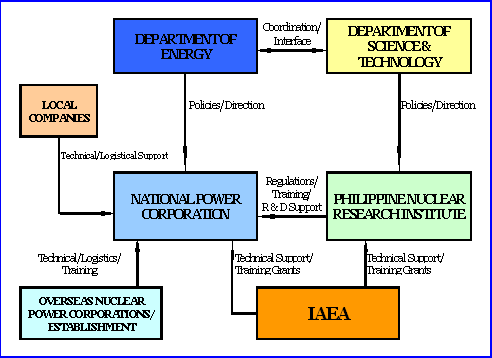
Source: www.pnri.gov.ph
Wikipedia
2.2 Nuclear Power Plants: Overview
2.2.1 Status and Performance of Nuclear
Table 7. Status and Performance of Nuclear Power Plants
| Station | Types | Net Capacity |
Operator | Status | Reactor Supplier |
Criticality | Construction Date |
Grid Date |
Commercial Date |
Shutdown Date |
UCF for year 2011 |
| BNPP-1 | PWR | 620 | Cancelled Constr. | RPNPC | WH | 1976-07-01 | 1986-05-01 |
Source: PRIS database (www.iaea.org/pris)
2.2.2 Plant upgrading, plant life management and license renewal
The Bataan Nuclear Power Plant is under preservation. Since its completion in 1986, a preservation team from the National Power Corporation has been working to preserve the plant’s condition.
Due to the need for a cheap and safe power generation facility, the Philippine government is considering the rehabilitation of BNPP by virtue of House Bill No. 1291, filed at the Fifteenth Congress.
The Korea Electric Power Corporation (KEPCO) performed a feasibility study on BNPP in February-April 2009.
2.3 Future Development of Nuclear Power
2.3.1 Nuclear Power Development Strategy
Since the creation of the DOE in 1992, only the Philippine Energy Plan (PEP), covering the planning period 1998-2035, incorporated nuclear as a long-term energy supply option. The 1998 Plan forecast developed four (4) scenarios to determine its sensitivity to different energy policy alternatives and to determine the impact of regional co-operation programs. Under this plan, a 600 MW nuclear power plant will be operational by 2025. Additional nuclear plant units, 600 MW each were planned to be completed in 2027, 2030 and 2034. Thus, under the PEP 1998-2035, the total nuclear capacity was projected to reach 2,400 MW by the end of the planning period. At present, a bill for the recommissioning of the BNPP is pending in the Philippine congress which, if passed, would hasten the nuclear program for the Philippines. Similarly, operation of this power plant would trigger the construction of more units. When the BNPP recommissioning bill is approved, a feasibility study for the plant’s recommissioning will be undertaken and, within a period of three (3) to five (5) years, BNPP may be put into operation.
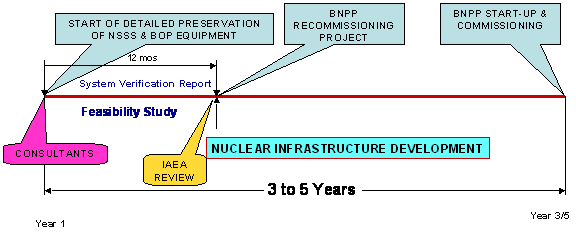
The contract for the recommissioning of BNPP may be made through a government-to government arrangement. For the nuclear power cycle involving the BNPP, the recommended parties from whom the Philippine government would contract its recommissioning project would be the prime consideration. However, for future programs, the current Philippine strategy for the back-end of the cycle would be long-term storage of spent fuel on-site, while awaiting the establishment of the Philippines’ National Radwaste Repository Center. A suitable site within the Philippines has already been identified for this center.
Table 8. PLANNED NUCLEAR POWER PLANTS
| Expected Construction Start Year | Expected Commercial Year | |||
| BNPP | PWR | 620 MW | - | - |
| NPP 1 | PWR | 600 MW | 2015 | 2025 |
| NPP 2 | New Generation NPP | 600 MW | 2017 | 2027 |
| NPP 3 | New Generation NPP | 600 MW | 2020 | 2030 |
| NPP 4 | New Generation NPP | 600 MW | 2025 | 2035 |
Source: Philippine Energy Plan
2.3.2. Project management
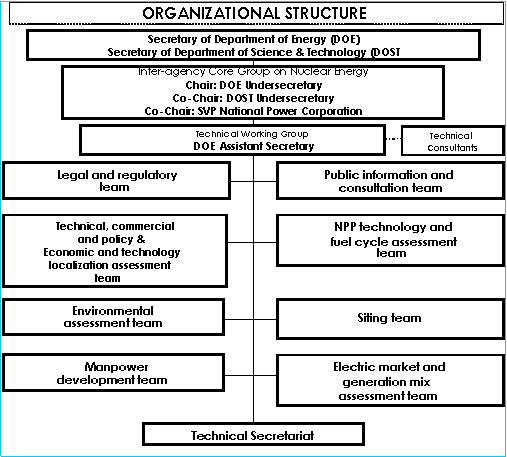
The development of the country’s nuclear power program is vested under a governmental ad-hoc committee, described in the above diagram. By virtue of an inter-departmental order between DOE and DOST, this inter-agency Core Group on nuclear energy was created. Its prime objective is the development, management and setting-up of policies and strategies which will involve nuclear power generation. Part of the mandate is the feasibility study for the possible re-operation of BNPP.
2.3.3 Project Funding
A nuclear power project would be funded by an external financing organization, in view of the huge capital cost necessary in building a new plant. Likewise, in the case of BNPP recommissioning, external funding may be required. However, the recommissioning bill has made certain provisions in the electricity tariff as a source of funds for BNPP.
2.3.4 Electric Grid Development
Electricity demand growth slowed down over the years, from an average rate of 6% in Luzon, 7.6% in Visayas and 4.4% in Mindanao, during the 90s, to an average of 2.6% in Luzon, 6% in Visayas and 3.3% in Mindanao, for the period 2000-2008. This can be attributed to factors such as structural change of the national economy, from industry-led to services-driven growth. In the cases of Visayas and Mindanao, other contributing factors are suppressed demand considering the tight power supply, which hinders the potential for growth. It is assumed that the economic structure of the Philippines will remain the same henceforth. In addition, we are looking forward to greater efficiency gains, in response to rising energy prices and aggressive promotion of energy conservation, and in response to energy efficiency programs for lighting system and other modes of demand-side management. By 2030, the country’s energy sale is projected to increase from 55,417 GWH in 2008, to 86,809 GWH by 2018, and up to 149,067 GWH by 2030. Described in terms of peak demand, these can be seen as equivalent to 9,226 MW in 2008, rising to 14,311 MW by 2018 and to roughly 24,534 MW by 2030.
New high-voltage transmission lines and switchyard upgrades are necessary for the recommissioning of BNPP, as well as for new power plants.
2.3.5 Site Selection
In 1998, the government created the Nuclear Power Steering Committee to provide for the direction of the country’s nuclear power program during this period. It identified numerous sites throughout the country as possible future sites for nuclear power plants, as shown in the figure below.
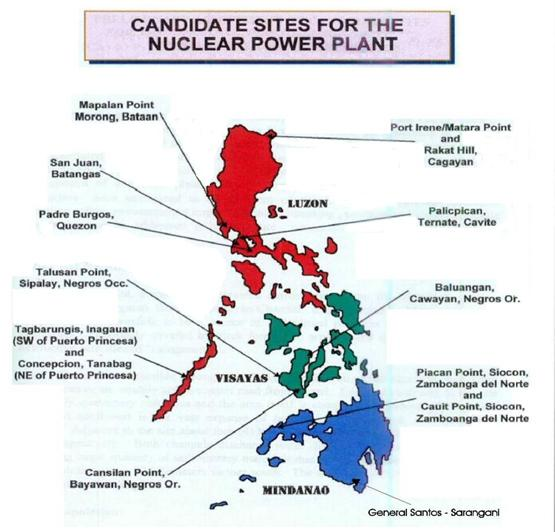
Except for the Bataan site, this survey of sites would only need updating for the Environmental Impact Assessment. All sites are located near the sea, hence the presence of abundant cooling water. Likewise, all identified sites are accessible by land transportation and a practical distance from transmission lines.
2.4 Organizations involved in construction of NPPs
The Philippines, acting through the National Power Corporation, will be the main player involved in the erection of new nuclear power plants as well as in the possible recommissioning of BNPP. This position is based on existing laws, and partly due also to the vast experience that has been gained in the fields of electric power generation and construction. It has its own engineering, technical services and project management organizations, which are well equipped to handle the pre-construction activities, construction stage, operation and maintenance, and decommissioning of a nuclear power plant.
2.5 Organizations involved in operation of NPPs
The National Power Corporation will be responsible for the operation of Philippine nuclear power plants.
2.6 Organizations involved in decommissioning of NPPs
For the decommissioning of NPPs, it will be the National Power Corporation who will implement activities.
2.7 Fuel Cycle Including Waste Management
For the country’s first operational nuclear power plant, the front-end of the nuclear fuel cycle will be sourced through foreign expertise, as was the case with BNPP. BNPP’s fuel supply contract with Westinghouse included mining and milling, uranium conversion, and enrichment up to the stage of fuel fabrication. The same system would be applied to new plants, and to BNPP, should it be put into operation.
The new technology for on-site interim storage of spent fuel would be used, until a firm governmental decision is issued with regards to future use of spent fuel. If BNPP is put into operation, the storage facility will be set up.
Reprocessing is not among the priorities for the nuclear program, at present. Should there be decision on the reprocessing of spent fuel for conversion into fuel again, then it will be sent to a country where the industry is already in place.
On the issue of waste management, the Philippine Nuclear Research Institute (PNRI), through IAEA technical and financial assistance, has already identified suitable sites within the Philippines for its National Radwaste Repository Center. The center is being set up for the long-term storage of high-level wastes coming from hospitals, from the PNRI itself and from future nuclear power plants.
2.8 Research and Development
2.8.1 R&D Organizations
At present, the PNRI has a mandate on R&D in the field of nuclear sciences and technology. The country does not have any private institutions that cater to this field. However, the pending bill in Congress on the reactivation of BNPP has included provisions for nuclear research and development. Upon embarking on the road to nuclear power, it is also considered certain that the country’s science and technology industry will begin R&D on nuclear topics.
2.8.2 Development of advance nuclear technologies
At present, the country is not engaged in any advanced nuclear technology development.
2.8.3 International Co-operation and Initiatives
On an international level, the PNRI acts as the national government agency, representing the country as a member state in the IAEA. PNRI has co-operative agreements with 16 Member States of the Regional Cooperative Agreement (RCA) for research, development and training related to nuclear sciences and technology for Asia and the Pacific. The PNRI partners with several organizations and entities like the RCA Regional Office (RCARO), Forum for Nuclear Cooperation in Asia (FNCA), Comprehensive Nuclear Test Ban Treaty Organization (CTBTO) and other organizations from Australia, Canada, Japan, Korea, United States and other countries through bilateral agreements/institute-to-institute agreements.
2.9 Human Resources Development
The present government is putting a premium on human resource capability building and enhancement as a necessary prelude to considering nuclear power as a long-term energy option. Capability building and enhancement with regards to the various aspects of nuclear energy will involve training local manpower for the possible introduction of nuclear power into the country’s energy system.
Currently, the DOE, as the focal governmental institution for the nuclear power program, is leading an inter-agency discussion among the concerned governmental organizations, the academic sector and the private sector to thresh out the responsibilities of re-building local technical capability in nuclear sciences and engineering. Due to the retirement of many engineers, new manpower will be recruited and developed.
2.10 Stakeholder Communication
A communication program, titled BNPP Communication Plan, and intended to be implemented by the NPC’s Corporate Communications, is currently on the drawing board with the following objectives:
Raise level of awareness among concerned public, on the benefits of nuclear power in general and on the revival of the BNPP in particular.
Address the issues being raised by anti-nuclear and anti-BNPP groups, through various methods.
Create an environment in which the revival of BNPP is positively viewed, and accepted as a possible option in addressing the lack of generation capacity.
The target audiences are the general public, media, decision-makers and stake-holders such as the Philippine Congress, local government units (LGUs), church, local media, non-governmental organizations and the private sector.
Communication approaches will be through the tri-media (TV, print and radio) approach of press releases, features stories and interviews, and guest/personal appearances to relevant talk shows. The other approach is the inter-personal approaches like the conduct of fora and symposia with students from major academic institutions and LGUs within the vicinity of BNPP and will include sponsorship tours to the plant site. The media to be used will be the major broadsheets and magazines, leaflets, posters and flyers, comic book and fire-minute featurettes and visual productions on TV.
3. NATIONAL LAWS AND REGULATIONS
3.1 Regulatory Framework
3.1.1 Regulatory Authority
The present nuclear regulatory authority is the PNRI, formerly the Philippine Atomic Energy Commission or PAEC. The PNRI’s basis for nuclear power plant regulation is the USNRC Code of Federal Regulations (CFR).
3.1.2 Licensing Process
The licensing procedure involves three (3) main processes.
First is the Provisional Permit stage, where a licensee is issued with a provisional permit or limited work authority.
Next is the Construction Permit Stage, where a construction permit is issued upon the licensee’s satisfaction of or compliance with the various requirements of the Preliminary Safety Analysis Report (PSAR).
The third stage is the Operating License stage. After completion of all conditions present(regulatory requirements, licensing of operators, etc), an operating license is issued, through which the licensee can proceed with Fuel Core loading and initiate reactor operation for criticality.
3.2 Main National Laws and Regulations in Nuclear Power
Republic Act No. 2067 (Science Act of 1958) created the Philippine Atomic Energy Commission (PAEC). At the initiative of PAEC, the Congress enacted RA 3859 amending RA 2067. This provides PAEC with a dual mandate to promote the peaceful applications of atomic energy and to license and regulate the use of radioactive materials.
Republic Act No. 5207 (Atomic Energy Regulatory and Liability Act of 1968) was enacted by Congress to establish the comprehensive nuclear regulatory function of PAEC. It provided PAEC with the authority to issue licenses for the construction, possession and operation of any atomic energy facility. It also served as a basis for the promulgation of rules and procedures in the licensing of nuclear power plants.
Republic Act No. 6395, enacted in 1971, authorized the National Power Corporation (NPC) to establish and operate nuclear power plants.
Presidential Decree No. 606, issued on December 13, 1974, constituted PAEC as an independent and autonomous body, transferring it from the National Science Development Board (NSDB) to the Office of the President (OP).
With the creation of the Ministry of Energy (MOE), under Presidential Decree No. 1206, dated October 06, 1977, PAEC was transferred from the Office of the President to the control and supervision of the MOE.
Executive Order No. 613, dated August 15, 1980, transferred PAEC from MOE back to the Office of the President.
Code of PAEC Regulations (CPR), promulgated in April 1981, under Administrative Order No. 1 Series of 1981. The National Standards/Regulatory Requirements were as follows:
CPR Part 3, “Standards for Protection Against Radiation”
CPR Part 4, “Rules and Regulations on the Safe Transport of Radioactive Material”
CPR Part 7, “Licensing of Atomic Energy Facilities”, based mainly on US NRC documents and IAEA standards, codes and guidelines.
Executive Order No. 708 promulgated on July 27, 1981, attached PAEC to the Office of the Prime Minister.
On March 17, 1984, Executive Order No. 784 reorganized NSDB to National Science and Technology (NSTA) and placed PAEC under its administrative supervision. Executive Order No. 980, dated August 29, 1984, converted PAEC from a single-headed agency to a multi-headed agency, with a Chairman and four (4) Associate Commissioners forming the Board of Commissioners. It reaffirmed PAEC’s role as the nuclear regulatory board.
In Executive Order No. 128, dated January 30, 1987, the NSTA was reorganized to the Department of Science and Technology (DOST), and PAEC become the Philippine Nuclear Research Institute (PNRI), headed by a Director and assisted by a Deputy Director.
House Bill No. 6300: An Act Mandating the Immediate Rehabilitation, Commissioning and Commercial Operation of the Bataan Nuclear Power Plant, Appropriating Funds therefore, and for other Purposes (2009).
House Bill Nos. 3155 and 3254: An Act to Regulate the Nuclear, Security and Safety Aspects in the Peaceful Utilization of Radiation Sources through the Creation of the Philippine Nuclear Regulatory Commission, Appropriating Funds therefore, and for other purposes (2009).
House Bill No. 1291: An Act Mandating an Immediate Validation Process which satisfies Internationally Accepted Nuclear Power Industry Norms to Determine the Bataan Nuclear Power Plant’s Operability Culminating In Either The Immediate Rehabilitation, Certification And Commercial Operation Or, The Immediate Permanent Closure And Salvage Value Recovery, of the Bataan Nuclear Power Plant, Appropriating Funds Therefore, And For Other Purposes (July 2010).
REFERENCES:
Philippine Energy Plan 2007-2014, “Fueling Philippine Development through Greater Access to Energy”, DOE
Highlights of the 2009-2030 Philippine Energy Plan, DOE.
PNRI @ 50, “ Making Science and Technology Work for You,” PNRI 2008
PNRI Nuclear Research Institute Annual Report 2007
Philippine Nuclear Power Plant Unit 1, General Information and Technical Features, National Power Corporation, Engineering Division, February 1984.
APPENDIX 1: International, Multilateral and Bilateral Agreements
International Treaties, Conventions and Agreements Signed/Ratified
The Convention on Nuclear Safety
The Joint Convention on Safety of Spent Fuel Management and on the Safety of Radioactive Wastes
The Joint Protocol Relating to the Application of the Vienna and Paris Convention
The Protocol to Amend the Vienna Convention on Civil Liability for Nuclear Damage.
Convention on Supplementary Compensation for Nuclear Damage
The Protocol Additional to the NPT Safeguards Agreement
A Party to the Southeast Asia Nuclear Weapons Free Zone Treaty.
Cooperation Agreements with IAEA in Area of NP
Human Resources Development and Nuclear Technology Support, 2003-2008
Development of a Near-Surface Radioactive Waste Disposal Facility, 2007-2008
Bilateral Agreements with other Countries or Organizations Signed/Ratified by the Country in the Field of Nuclear Power.
Memorandum of Understanding for Cooperation on the Nuclear Power Project in the Philippines between NPC and KEPCO.
APPENDIX 2: Main Organizations, Institutions and Companies Involved in Nuclear Power Related Activities.
Name : National Power Corporation (NPC)
Address : National Power Corporation
Quezon Avenue Corner BIR Road, Diliman
1100 Quezon City, Philippines
Telephone : +63 2 9213541 to 79
Facsimile : +63 2 9212468
Email : mlmarcelo@napocor.gov.ph
URL : http://www.napocor.gov.ph
Activity : Government Electric Utility Company
Name : Department of Energy (DOE)
Address : Energy Complex, Meritt Road Fort Bonifacio
Taguig City, Philippines
Telephone : +63 2 8402286
+63 2 8402232
Facsimile : +63 2 8406194
Email : rdalmendras@doe.gov.ph
URL : http://www.doe.gov.ph
Activity : Governmental Agency for Energy Policies
Name : Philippine Nuclear Research Institute (PNRI)
Address : Commonwealth Avenue, Diliman
1100, Quezon City, Philippines
Telephone : +63 2 9296010 to 19
Facsimile : +63 2 9201646
URL : http://www.pnri.dost.gov.ph
Activity : Governmental Institution for Beneficial use of nuclear
Science and technology, including regulations, safeguards, licensing and control of nuclear utilities and materials.
Name of Report Coordinator : MAURO L. MARCELO, JR.
Institution : National Power Corporation
Telefax : +63 2 9227848 (Landline)
Telephone : +63 928 5089857 (Mobile)
Email : mlmarcelo@napocor.gov.ph
Name of Report Coordinator : JOSE G. MANALO
Institution : National Power Corporation
Telephone : Bataan Nuclear Power Plant
Telefax : +63 2 9245313
Email : joemcwin@yahoo.com
